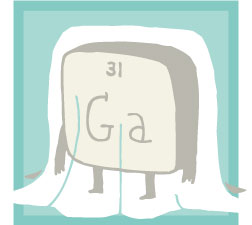Blogging the Periodic Table

It's hard to imagine today, but when scientists introduced the periodic table, it was merely a conjecture. It had to fight for attention and defend itself against attacks, and could easily have been abandoned. In fact, the table faced its first big test less than a decade after Dmitri Mendeleev produced his famous table in 1869. The element in question was gallium.
Mendeleev didn't discover the periodic nature of elements by himself—at least five other scientists also suggested that, if you arranged the elements by increasing weight, certain properties would reappear at regular intervals. And Mendeleev's first table didn't look like the one we know today—it was flipped sideways, with rows for columns and columns for rows; someone else suggested he rotate it. But Mendeleev earned his place in history as the father of the periodic table for good reason: He incorporated more elements than anyone had before and did a better job of putting them in their proper spots.
Mendeleev also did something special with the gaps on the table. All the early periodic tables had holes where no known element fit. We know today they simply hadn't been discovered yet. But that wasn't necessarily obvious back then—perhaps they didn't exist, or perhaps the theory behind the periodic table wasn't true. Mendeleev, however, not only predicted that new elements would be discovered and that they would support his periodic system; he also had the audacity to predict the properties of undiscovered elements. One of his predictions concerned the ghost element below aluminum, which Mendeleev named eka-aluminum, using the Sanskrit word for "beyond." When a French aristocrat discovered eka-aluminum in 1875, Mendeleev tried to claim part of the credit. After all, he'd predicted it.
The aristocrat, Paul Emile François Lecoq de Boisbaudran, refused to let Mendeleev horn in on his discovery, however, and the two began to argue in papers in scientific journals. Lecoq de Boisbaudran first claimed that he'd never heard of Mendeleev's system, and later argued that Mendeleev had stolen the system anyway from an obscure French scientist who also had seen a glimmer of periodicity in the elements. For his part, Mendeleev picked apart Lecoq de Boisbaudran's data on the new element (soon named gallium). Mendeleev claimed, largely without evidence, that the accomplished Lecoq de Boisbaudran must have made mistakes when measuring gallium's weight and density, since they differed from Mendeleev's predictions.
The chutzpah here is incredible, but Mendeleev tended to trust his own instincts and formulas over mere evidence. Crackpots often do. The difference between Mendeleev and most crackpots is that Mendeleev was right: Lecoq de Boisbaudran soon had to publish an embarrassing retraction about gallium's weight and density, changing them to values that vindicated Mendeleev. According to science philosopher and historian Eric Scerri, "The scientific world was astounded to note that Mendeleev, the theorist, had seen the properties of a new element more clearly than the chemist who had discovered it."
This wasn't the only early trial that the periodic table faced. But the incorporation of the new element gallium was the first, and it helped prove the table wasn't just a clever but misleading arrangement of elements. It was a scientific tool with real predictive powers, something that could help scientists find new elements and refine what they knew about others. They could no longer ignore this powerful way to understand and organize the elements that make up the universe.
Like Slate on Facebook. Follow us on Twitter.